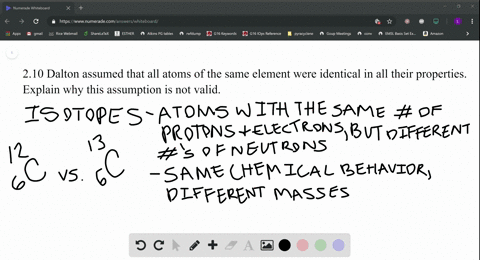The question of whether John Dalton, the pioneering figure in atomic theory, believed that atoms and molecules were synonymous invites a nuanced exploration of his scientific philosophy. Dalton’s inquiries fundamentally reshaped the 19th-century scientific milieu, leading to a greater understanding of matter. His theories linked the microscopic and macroscopic realms, thereby heralding a paradigm shift in how we perceive the structure of matter.
To grasp the intricacies of Dalton’s belief system, one must first examine his foundational atomic theory. Proposed in the early 1800s, Dalton posited that all matter comprises indivisible particles known as atoms. He asserted that atoms of a given element are identical in mass and properties, which was revolutionary at the time. This homogeneity among constituent atoms of a single element was crucial in formulating the notion of atomic weight and the conservation of mass.
However, Dalton’s perspective on molecules diverged significantly from contemporary views. While it is common today to consider atoms and molecules as part of a continuum, Dalton’s assertions reflected a more rigid classification. To him, an atom was an ultimate particle that could not be further subdivided, whereas molecules represented combinations of these atoms. Dalton articulated that a molecule—defined as the smallest unit of a compound that retains its chemical properties—was the product of atomical association rather than an atomic entity in its own right.
This distinction becomes particularly relevant when analyzing his work on chemical compounds. For instance, Dalton’s law of multiple proportions illustrates his understanding of how different elements combine in specific ratios to form various compounds. This functionality underscores his belief in distinct roles for atoms and molecules: atoms serve as the elementary building blocks, while molecules serve as combinations of these blocks. Such differentiation recognizes the profound complexity of molecular formation, including the particular arrangements and interactions of individual atoms.
Moreover, Dalton’s use of symbols to represent atoms in chemical reactions further amplifies this distinction. His symbolic representation mapped a framework for chemical phenomena that unequivocally delineated between individual atoms and assemblies of atoms—an aspect not merely semantic but foundational for the budding field of chemistry. Thus, while atoms remained abstract singularities, molecules emerged as complex aggregates embodying unique properties derived from the characteristics of their constituent atoms.
It is imperative to consider how Dalton’s theories catalyzed an ontological shift in scientific inquiry. By asserting a systematic approach to elements and their compounds, he instigated a broader view that intertwined empirical observation with theoretical postulation. The evolution of concepts such as molecular weight and valency became possible through our understanding of Dalton’s differentiated yet interconnected treatment of the atomic and molecular worlds.
The implications of Dalton’s interpretation extend into the realms of stoichiometry and chemical equations, where a molecule is viewed as a distinct entity representing compound interactions. In Dalton’s framework, chemical reactions could be approached with a quantitative lens, reinforcing the necessity of understanding both atomic quantities and the molecular aggregates they form. His approach invited subsequent scientists, like Avogadro and Mendeleev, to refine and expand upon these ideas, ultimately leading to the atomic model we are familiar with today.
In contemporary contexts, our comprehension of atoms and molecules has transcended Dalton’s rudimentary definitions. Yet, revisiting his work compels us to reflect on the implications of viewing these entities through a historical lens. For modern scientists, the challenge remains to unify theories of atomic interactions while respecting the discrete origins traced back to Dalton’s assertions. As research delves into quantum mechanics and non-classical phenomena, understanding Dalton’s legacy becomes pivotal for contextualizing advances in atomic theory.
Curiously, Dalton’s philosophies also hint at the broader implications for scientific thought. The coexistence of atoms and molecules as distinct yet related entities paves the way for interdisciplinary dialogues. For example, approaches in nanotechnology often consider the behavior of atoms and molecules in environments where classical distinctions break down. This confrontation of Daltonian principles with the complexities of contemporary atomic interactions evokes questions that scientists and theorists grapple with today.
Furthermore, the inquiry into Dalton’s perspective on atoms and molecules prompts an evaluation of the nature of scientific classification itself. It underscores a fundamental tension between simplification and complexity within scientific disciplines. As scholars continue to dissect the minutiae of atomic theory, they are reminded that scientific advancement is rooted not in absolute dichotomies but in an ever-expanding tapestry of inquiry.
In summation, while John Dalton distinctly recognized atoms and molecules as separate entities, his contributions laid the groundwork for our enduring fascination with the subtleties of matter. His insistence on the unique properties of atoms and the various combinations they form encourages a rich dialogue that persists in modern scientific exploration. As curiosity unfurls around the intricacies of atomic and molecular interactions, one can only reflect on how Dalton’s foundational assertions reverberate through the corridors of science, inviting new interpretations and inspiring generations of researchers.












